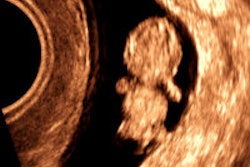
AuntMinnie.com presents the 21st in a series of columns on the practice of ultrasound from Dr. Jason Birnholz, one of the pioneers of the modality.
If asked about the accuracy of ultrasound for identifying situs inversus in a fetal ultrasound in the second or third trimester, I'd have said at least 99%, leaving room, maybe, for rare situations with chronic severe oligohydramnios and near-zero visibility. I'm pretty sure I would have given the same answer anytime since the early 1970s.
 Dr. Jason Birnholz.
Dr. Jason Birnholz.However, I started to wonder about that surmise when I heard of a recent case at a local academic institution where situs inversus was missed on multiple fetal exams. It was discovered in early infancy because of malrotation and volvulus.
It is not easy to determine how often situs inversus is found or missed in routine prenatal exams, especially with an incidence of about one in 4,000 and a frequent absence of overt health issues in the afflicted. One paper from Children's Heart Center Nevada (Evans WN et al, Pediatric Cardiology, January 14, 2015) reported a detection rate of 68% in 2002, which later improved to the expected 100% in 2013.
How might we explain the baseline rate of 68%, which may very well be lower in less-expert scanning units?
The radiologist brain
When I applied for a diagnostic radiology residency, there was radiography or video fluoroscopy, each with its variations, techniques, and applications. The interviewers, whether they knew it or not, and the apprentice-like rotations during the residency, all sought to identify a particular visual-spatial talent of effortlessly forming a mental 3D spatial model of a body part, rotating it as needed about any axis.
One of the principal maneuvers in fluoroscopy is to locate a lesion or structure by rotating the patient or some body part about an axis and seeing which way the object shifts. In chest films, the equivalent is to identify the pulmonary subsegment from appearances in frontal and lateral (and sometimes oblique) views.
My teachers all had this ability, probably innately, so they just did it and assumed everyone else could too. Perhaps this is like a child with the much rarer talent of perfect pitch who identifies individual or multiple simultaneous notes automatically and with perfect accuracy, and only later learns this is not universal.
In a study that was published in Radiology in 2005, Swiss researchers performed functional MRI scans on both radiologists and nonradiologists while showing them various kinds of films. They found several distinct differences for radiologists, including selective activation of some left-sided parietal lobules -- identified as being strongly involved in mental rotation of complex stimuli and for spatial working memory.
Finding situs inversus
There is fluid plainly visible in the fetal stomach, pretty much anytime after the middle of the first trimester, and the head and spine are obvious even earlier. The way I would describe identifying situs for beginners is to form a mental image of a baby or a doll floating horizontally in space before them. Locate the head as toward you or away from you and note the position of the spine like compass points or on a clock face.
If the fetus is in breech position and the spine is at 3 o'clock, the left side is up and the stomach should be in the top of the abdominal field in a transverse view. With vertex presenting, you get the same positioning with the spine at 9 o'clock. In real scanning, start with a four-chamber view of the heart with the transducer in front of the chest. The line of the interventricular septum toward the front of the chest defines the axis of the heart.
Angle the probe toward the fetus' feet: The stomach and spleen should be evident. Go back to the heart: The axis of the heart should align with the side of the stomach. Continuing the cephalad angulation reveals, first, the aortic root angled to the opposite side, and then the pulmonic outflow tract with an isolateral direction. All it takes is one transverse plane sweep of the transducer array.
Handshaking and x-ray viewing conventions
Chest x-rays are always positioned on light boxes or monitors as if you are looking directly at a patient, who is looking back at you. The standard chest film is performed with the x-ray source behind the back and the chest against the sensor or film cassette, i.e., posterior to anterior. The image is reversed to maintain the convention. Lateral views are oriented with the patient's front toward the viewer's left. Most x-ray departments require that technologists affix a lead marker to the cassette identifying the laterality of the film relative to the patient.
Chest x-rays can be oriented up or down, back or front. That's four different ways. The random chance of getting it "right" is therefore one in four, which probably explains why chest films in the background of so many TV shows set in morgues, doctors' offices, or ORs are more often wrong than right.
 The persistence of right-handed handshaking. Funerary stele of Thrasea and Euandria image by Marcus Cyron. Licensed under CC BY-SA 3.0 via Wikimedia Commons.
The persistence of right-handed handshaking. Funerary stele of Thrasea and Euandria image by Marcus Cyron. Licensed under CC BY-SA 3.0 via Wikimedia Commons.I am pretty sure that medical students, worldwide, and for the past few centuries, have all been taught to take a patient's history face to face wherever possible and to do a physical exam from the patient's right side, independent of their handedness. Could it be that there are basic perceptual reasons for this and other ultrasonic and physical exams and other historically persistent right-handed activities such as handshaking?
Feng shui
Have you ever arranged or rearranged an ultrasound room? You may not have a lot of choice for windows or lighting or the placement of electrical outlets. You will want to think of the position of the patient relative to the door to preserve modesty and confidentiality.
In radiology ultrasound suites, rooms are configured with the examiner and equipment on the patient's right. The probe is usually held in the right hand, with the left free for manipulating controls or acquiring permanent images or video clips. You need to know the arrangement and display convention to decipher the laterality of imaging findings unambiguously.
I have had a chance to visit a lot of ultrasound facilities, including exam rooms in other specialties with innovative arrangements, especially in fields like obstetrics, where laterality, per se, is not a major concern. This emphasis may also have passed its primacy in radiology, as CT and MRI with their rigid patient positioning requirements differ from the free-form scanning of ultrasound.
I couldn't come up with anything directly pertinent to ultrasound when writing this article, but I did find a U.K. study of about 100 senior fiber-optic bronchoscopists. Of these, 97% were right-handed and about 60% operated facing the patient on the patient's right (Mathew JJ, Howes T, Respiratory Medicine, June 2010, Vol. 104:6, pp. 921-922). The right-handedness is interesting in view of the tidbit above about the left parietal lobe being important for conceptual spatial orienting.
I have always been in favor of -- and tried to promote -- the diffusion of ultrasound from radiology into primary care venues. I have also thought that exams should be by physicians and that the process should be with full support from radiology.
On one hand, knowledge of the pathology that one may encounter in a particular situation is essential for structuring the exam, and on the other, there are a host of mainly unrecognized or unapparent factors, such as the perceptual ones noted herein, that can profoundly influence the accuracy of ultrasound imaging.
Global and local metrics
Because the fetal skull, spine, and stomach are gross structures, visible with any equipment that is or has been approved for clinical use, it is evident that missed prenatal recognition of situs inversus has to be operator error. Or, if operators assume this is a "diagnosis," which may not be in their job description, then it is an interpreter error when these functions are separated. Given fetal lie and knowing the local practice for image orientation, one can always determine fetal situs from a transverse abdominal view.
One of the major issues that has plagued ultrasound as long as I can remember is the impossibility of determining the accuracy of the method itself for a specific diagnostic task. The best we can do is to report the statistics of the experience of a facility under the conditions and timing of the "study."
There are legal, medical, and medical system consequences for performance metrics that are only local and not global. Standardization will be possible when we are at a technical plateau. I hope no one doing ultrasound would ever ask: Is it OK to miss situs inversus in a routine exam because it is rare and because many people with the condition seem to be normal?
Despite its apparent rarity, dextrocardia has become a trope in the media community used to "explain" survival with a major left chest injury or death with a lesser insult to the right-side chest in print, movie, and TV productions. Dextrocardia is the thoracic component of situs inversus, which means mirror imaging around the right-left axis of the body of the organs and vessels in the chest and abdomen.
The more correct term for complete mirror imaging is situs inversus totalis. Situs solitus is the term for "normal," and situs ambiguous is for the murky intermediate where some things are switched and others are not. Heterotaxy is a more general term, basically meaning "strange arrangement," but it is commonly applied to situs ambiguous. Situs ambiguous has a very high association with other congenital abnormalities, particularly the heart -- an area of notoriously poor prenatal diagnostic performance.
Situs inversus is an example of an observational condition with an old terminology, followed by a relatively recent phase of understanding of its nature and our current technology for unraveling its molecular genetics. As visceral laterality occurs in the first few weeks of embryogenesis, it is safe to assume that it has a genetic basis.
Trying to fit situs inversus into a Mendelian framework, it was thought that this was an autosomal recessive condition. However, now it's known that there are multiple recessive and dominant forms of transmission, so that the foundations are polygenic with the added complexity that they only affect thoracic and/or abdominal parts of the body. There are also reports of prenatal environmental promoters of the condition, including diabetes and cocaine.
Situs inversus was first reported by Fabricius at the start of the 17th century. Early in the 20th century, there was a syndromic association of situs inversus, sinusitis, and bronchiectasis, a triad referred to as Kartagener's syndrome from observations published in 1933. Situs inversus totalis occurs in about 50% of cases; most of the time there is limited or absent olfactory acuity, frequent inner ear infections, and male infertility from immotile sperm.
Cilia
Multiple, exquisite ultrastructural studies in the 1970s unmasked the common denominator, which involves the number, formation, and/or beat sequence of cilia on specialized cells throughout the respiratory tract and auditory system, and which comprise the motor for sperm. Kartagener's syndrome has been replaced by the broader and more exact designation of primary ciliary dyskinesia.
Even more impressive and technologically astounding discoveries during the next 25 years, and continuing now, are unraveling the gene expressions involved in ciliary structure and function. The prevailing notion from these elegant investigations is that visceral rotation during early development follows flow patterns established by ciliary motion at critical organizing patches of early mammalian embryos. At least 24 genes are operant in the formation, energy transport, and signaling pathways for cilia, some of which have also been implicated causally in polycystic kidney disease!
Congenital heart defects are common with all the heterotaxias, going from maybe 10% of cases with situs inversus to nearly all cases with situs ambiguous. Partial or focal rotation may be difficult to identify ultrasonically when there are no gross findings such as a missing or misplaced spleen. The basic concept is that there are temporally and spatially critical genetic events early in the first trimester that will result in situs inversus totalis; small variations in timing or spatial localization disrupt normal development in a region or individual organ. The heart has a well-known pattern of looping as it goes from a tube to a four-chamber pattern around six weeks after conception, which makes it particularly vulnerable.
For more on this topic, see the excellent and well-illustrated review article by Francis et al in the American Journal of Physiology - Heart and Circulatory Pathology (May 15, 2012, Vol. 302:10, pp. H2102-H2111).
Appreciation
Mathematical physicists have been mulling over the classic three-body problem for a few hundred years and have managed with great difficulty to identify about a dozen families of soluble movement patterns. Molecular genetics may be dealing with a playing field of 30,000 moving bodies. It is astoundingly complex, but there have already been awesome glimpses of how some parts of normal development happen and how distinct forms of pathology may arise.
Those of us who perform ultrasound can rightly take pride in our work and its consequences for patients, but we need to recognize that we use a relatively simple form of technology at a naked-eye level of organization. The heroes we need to emulate and the works we need to appreciate to progress in our craft are in the molecular realm. It is through their super high-tech, painstaking, diligent, frequently frustrating, and endlessly rechecked work that our own progress will be illuminated.
In other words, the sooner we replace the traditional observational, "syndromic" model of disease with goal-oriented exams based on principles established by molecular biology, the better we will all do.
Dr. Jason Birnholz was one of the few advanced academic fellows of the James Picker Foundation, and he has been a professor of radiology and obstetrics. He is a fellow of the American College of Radiology and the Royal College of Radiology, and he was an associate fellow of the American College of Obstetricians and Gynecologists.
The comments and observations expressed herein do not necessarily reflect the opinions of AuntMinnie.com.



















